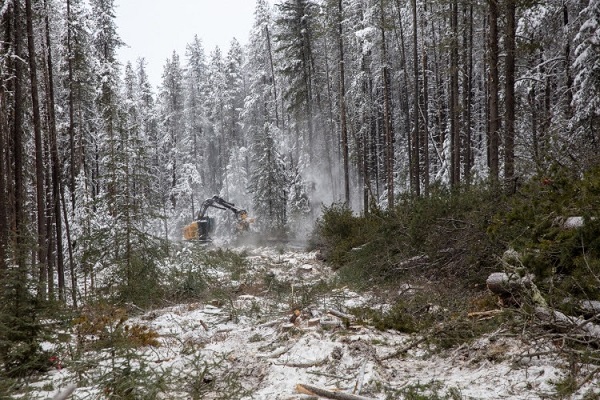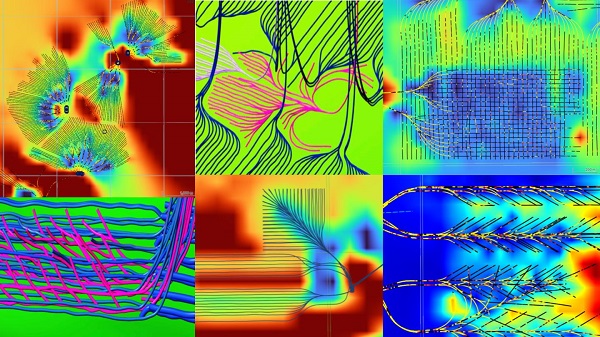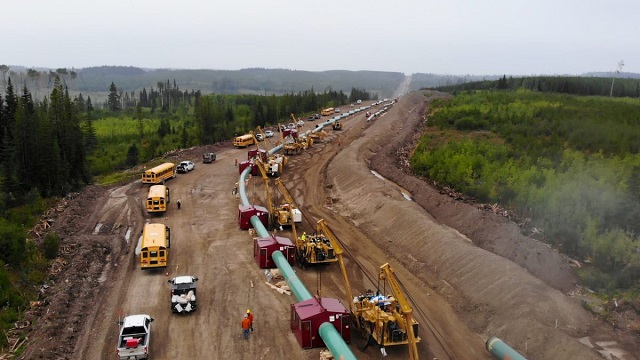Alberta
Community Fireguard Program Protecting Canmore and the Bow Valley from wildfires

Construction of the Bow Valley Community Fireguard near Canmore.
Mitigating the risks of catastrophic wildfires is a primary focus for Alberta’s government. With increased wildfire activity in recent years, it is crucial that communities at risk are prepared. The Community Fireguard Program is critical to these efforts. By removing trees surrounding vulnerable communities that can act as fuel in the event of fires, the program helps ensure that residents, homes, businesses and critical infrastructure are better protected from the devastating effects of wildfires.
Construction on the new Bow Valley Community Fireguard started in late fall 2024, after the project received $750,000 in provincial funding administered by the Forest Resource Improvement Association of Alberta. Project partners include the Town of Canmore, Municipal District of Bighorn and the Kananaskis Improvement District, with support from Alberta’s government.
“Alberta faced significant wildfire seasons over the last two years. The reality is that decades of fire suppression left our forests aging and vulnerable. By working together with our at-risk communities, we are taking steps to increase wildfire resilience across Alberta.”
Ongoing work on the fireguard, which includes a combination of mechanical tree removal and forest thinning, will significantly reduce the potential for a wildfire for years to come. Additional work is required to complete the entire fireguard over the next three to five years and planning is underway for the next funding approval and stage of construction.
“Wildfire is the hazard that poses the greatest risk to Canmore. With hotter, longer and more intense fire seasons, work on building the Bow Valley Community Fireguard is critical to ensuring that we have the means and the plans to combat this significant threat to people, property and critical infrastructure.”
“The Bow Valley Community Fireguard is a massive undertaking made possible through the province’s commitment to strengthening the wildfire resiliency of our communities. We are thankful for their continued support and leadership in advancing wildfire prevention initiatives across Alberta. We are also grateful for the countless hours of effort behind the scenes from the teams of the MD of Bighorn, the Town of Canmore, and the Kananaskis Improvement District that have brought this project to life to ensure the Bow Valley has a safer future for generations to come.”
Alberta’s government is taking significant steps to enhance wildfire preparedness across the province in preparation for the 2025 wildfire season, with several other fireguard initiatives currently underway. In Whitecourt, fireguard construction is ongoing, while in Hinton, fireguard planning is in progress. Swan Hills is focused on debris clean-up from 2023 fireguard construction to ensure continued wildfire protection for the area.
Additionally, work is underway to hire more wildland firefighters, who will receive specialized training at the Hinton Training Centre, which also provides free online training to municipalities and local fire departments. To support local communities, the province maintains mutual aid and resource-sharing agreements to ensure access to specialized firefighting equipment when needed.
The FireSmart program continues to help make properties more resistant to wildfires, and its principles are being implemented across the province. Alberta’s government is also continuing to implement prescribed burns and selective harvesting to reduce the risks of wildfires by removing aging trees.
Aggressive measures to reduce the mountain pine beetle population have also been effective, with work ongoing to cut and burn infested trees as needed.
Quick facts
- The Community Fireguard Program was launched in 2023 to enhance wildfire preparedness for communities at risk of wildfires.
- Alberta’s government invested $5 million to support emergency fireguard construction in 2023, in response to extreme wildfire activities.
- Emergency fireguards were constructed in Buck Creek, Grande Prairie, Dimsdale, Lac Ste. Anne, Valleyview, Gift Lake and Fox Creek.
- The program received an additional $14 million in 2024.
Related information
Alberta
Alberta bill would protect freedom of expression for doctors, nurses, other professionals

From LifeSiteNews
‘Peterson’s law,’ named for Canadian psychologist Jordan Peterson, was introduced by Alberta Premier Danielle Smith.
Alberta’s Conservative government introduced a new law that will set “clear expectations” for professional regulatory bodies to respect freedom of speech on social media and online for doctors, nurses, engineers, and other professionals.
The new law, named “Peterson’s law” after Canadian psychologist Jordan Peterson, who was canceled by his regulatory body, was introduced Thursday by Alberta Premier Danielle Smith.
“Professionals should never fear losing their license or career because of a social media post, an interview, or a personal opinion expressed on their own time,” Smith said in a press release sent to media and LifeSiteNews.
“Alberta’s government is restoring fairness and neutrality so regulators focus on competence and ethics, not policing beliefs. Every Albertan has the right to speak freely without ideological enforcement or intimidation, and this legislation makes that protection real.”
The law, known as Bill 13, the Regulated Professions Neutrality Act, will “set clear expectations for professional regulatory bodies to ensure professionals’ right to free expression is protected.”
According to the government, the new law will “Limit professional regulatory bodies from disciplining professionals for expressive off-duty conduct, except in specific circumstances such as threats of physical violence or a criminal conviction.”
It will also restrict mandatory training “unrelated to competence or ethics, such as diversity, equity, and inclusion training.”
Bill 13, once it becomes law, which is all but guaranteed as Smith’s United Conservative Party (UCP) holds a majority, will also “create principles of neutrality that prohibit professional regulatory bodies from assigning value, blame or different treatment to individuals based on personally held views or political beliefs.”
As reported by LifeSiteNews, Peterson has been embattled with the College of Psychologists of Ontario (CPO) after it mandated he undergo social media “training” to keep his license following posts he made on X, formerly Twitter, criticizing Trudeau and LGBT activists.
He recently noted how the CPO offered him a deal to “be bought,” in which the legal fees owed to them after losing his court challenge could be waived but only if he agreed to quit his job as a psychologist.
Early this year, LifeSiteNews reported that the CPO had selected Peterson’s “re-education coach” for having publicly opposed the LGBT agenda.
The Alberta government directly referenced Peterson’s (who is from Alberta originally) plight with the CPO, noting “the disciplinary proceedings against Dr. Jordan Peterson by the College of Psychologists of Ontario, demonstrate how regulatory bodies can extend their reach into personal expression rather than professional competence.”
“Similar cases involving nurses, engineers and other professionals revealed a growing pattern: individuals facing investigations, penalties or compulsory ideological training for off-duty expressive conduct. These incidents became a catalyst, confirming the need for clear legislative boundaries that protect free expression while preserving professional standards.”
Alberta Minister of Justice and Attorney General Mickey Amery said regarding Bill 13 that the new law makes that protection of professionals “real and holds professional regulatory bodies to a clear standard.”
Last year, Peterson formally announced his departure from Canada in favor of moving to the United States, saying his birth nation has become a “totalitarian hell hole.”
Alberta
‘Weird and wonderful’ wells are boosting oil production in Alberta and Saskatchewan

From the Canadian Energy Centre
Multilateral designs lift more energy with a smaller environmental footprint
A “weird and wonderful” drilling innovation in Alberta is helping producers tap more oil and gas at lower cost and with less environmental impact.
With names like fishbone, fan, comb-over and stingray, “multilateral” wells turn a single wellbore from the surface into multiple horizontal legs underground.
“They do look spectacular, and they are making quite a bit of money for small companies, so there’s a lot of interest from investors,” said Calin Dragoie, vice-president of geoscience with Calgary-based Chinook Consulting Services.
Dragoie, who has extensively studied the use of multilateral wells, said the technology takes horizontal drilling — which itself revolutionized oil and gas production — to the next level.
“It’s something that was not invented in Canada, but was perfected here. And it’s something that I think in the next few years will be exported as a technology to other parts of the world,” he said.
Dragoie’s research found that in 2015 less than 10 per cent of metres drilled in Western Canada came from multilateral wells. By last year, that share had climbed to nearly 60 per cent.
Royalty incentives in Alberta have accelerated the trend, and Saskatchewan has introduced similar policy.
Multilaterals first emerged alongside horizontal drilling in the late 1990s and early 2000s, Dragoie said. But today’s multilaterals are longer, more complex and more productive.
The main play is in Alberta’s Marten Hills region, where producers are using multilaterals to produce shallow heavy oil.
Today’s average multilateral has about 7.5 horizontal legs from a single surface location, up from four or six just a few years ago, Dragoie said.
One record-setting well in Alberta drilled by Tamarack Valley Energy in 2023 features 11 legs stretching two miles each, for a total subsurface reach of 33 kilometres — the longest well in Canada.
By accessing large volumes of oil and gas from a single surface pad, multilaterals reduce land impact by a factor of five to ten compared to conventional wells, he said.
The designs save money by skipping casing strings and cement in each leg, and production is amplified as a result of increased reservoir contact.
Here are examples of multilateral well design. Images courtesy Chinook Consulting Services.
Parallel
Fishbone
Fan
Waffle
Stingray
Frankenwells
-

 Health22 hours ago
Health22 hours agoTens of thousands are dying on waiting lists following decades of media reluctance to debate healthcare
-

 Business2 days ago
Business2 days agoI Was Hired To Root Out Bias At NIH. The Nation’s Health Research Agency Is Still Sick
-

 Opinion17 hours ago
Opinion17 hours agoLandmark 2025 Study Says Near-Death Experiences Can’t Be Explained Away
-

 Carbon Tax1 day ago
Carbon Tax1 day agoCarney fails to undo Trudeau’s devastating energy policies
-

 International1 day ago
International1 day agoCanada’s lost decade in foreign policy
-

 Business22 hours ago
Business22 hours agoBudget 2025: Ottawa Fakes a Pivot and Still Spends Like Trudeau
-

 armed forces1 day ago
armed forces1 day agoCanada At Risk Of Losing Control Of Its Northern Territories
-

 Business2 days ago
Business2 days agoLarge-scale energy investments remain a pipe dream











